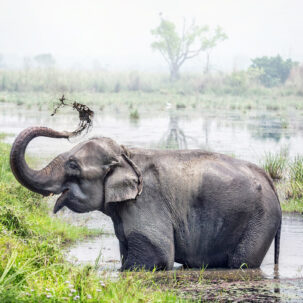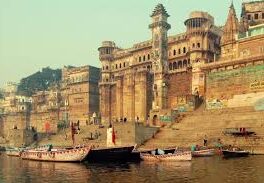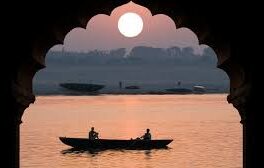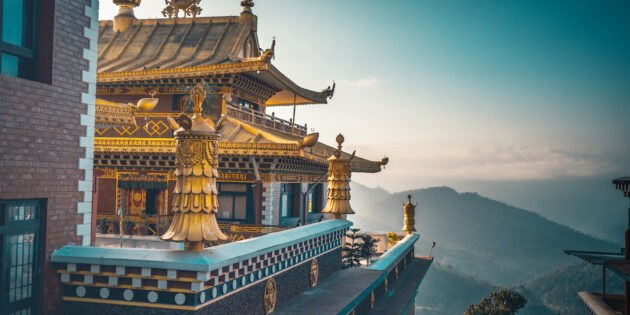In The Time of the Buddha
Pilgrimage-Retreat
Nepal and India – November 14–27, 2023
Itinerary
Overview | Itinerary | Travel Planner
Spring comes with its flowers, autumn with the moon,
summer with breezes, winter with snow;
when useless things don’t stick in the mind,
that is your best season. — Wumen Huaikai
Day 1, Tuesday, November 14, 2023.
Tour participants gather in the lobby of the Kathmandu WoodApple Hotel and Spa at 1pm. Our hotel has an alluring roof-top breakfast restaurant, and has vegetarian offerings. We will be in the Thamel neighborhood district, rich in galleries, handicraft markets, cafés, cycle rickshaws and pubs. Several hundred yards from our hotel is the family run Yangling Tibetan Restaurant, a popular place for Tibetan refugees, and offering up the best dumplings called momos.
Walking tour of Kathmandu, beginning with nearby The Garden of Dreams, an extraordinary botanical oasis of ponds, pergolas, and originally six pavilions, symbolizing the six seasons of Nepal: spring, early summer, summer monsoon season, early autumn, late autumn, and winter.
Walking tour of iconic old Durbar Square, home to historic temples and shrines, dating back to the 3rd Century. A UNESCO World Heritage Site, the Square complex is profoundly important for Buddhist and Hindu sacred rituals, holy ceremonies, and royal events.
We will also visit the 5-acre Mohan Chowk and Sundari Chowk courtyards, ritual baths, and meditative ponds inside the Hanuman Dhoka complex, once the residence of the Malla kings. Here we will see impressive wood carving sculptures depicting the adventures of young Krishna.
Our walking tour will be followed with a convivial Nepalese Welcome Dimmer.
Day 2, Wednesday, November 15 – Day tour of Kathmandu.

Boudhanath Stupa, largest Asian Stupa, UNESCO World Heritage Site, Kathmandu, Nepal, Asia
After breakfast we will visit Bouddhanath Stupa, located on the outskirts of Kathmandu, a massive structure in the form of a mandala.
Stupas are sacred mounds of earth layered with centuries of plaster. They are large hemispherical domes, marking Buddhist holy places or sacred relics. Boudhanath is a compelling destination for pilgrims. A large number of Tibetan refugees and Buddhist devotees live around this stupa. There are more than 50 monasteries around the stupa complex. We will circumambulate the stupa, joining Nepalese pilgrims and devotees from many cultures visiting from all over the world.
We will then visit Patan Durbar Square, one of the three important Durbar Squares in the Kathmandu Valley, situated at the centre of the city of Lalitpur in Nepal. Patan Durbar Square is well known for its architectural splendor and its Nepali crafts, a synthesis of regional styles.
The Newari artisans of the Kathmandu Valley developed a distinctive style, mostly in woodwork with astonishing grace and flamboyant nuances. The stupas here are some of the oldest stupas in Nepal, commissioned by Indian King Ashoka, a devout Buddhist who visited the KathmanduValley in the 3rd Century B.C.
These jaw-dropping treasure structures will take your breath away. Nepal is the birthplace of the pagoda, mostly in Hindu temples, a 13th Century creation by Nepalese architect named Arniko Rajmarg, and later adopted throughout Asia.
Hindu temples are built around a central sanctum that houses the temple’s deity. The sanctum is brick, with elaborately carved wooden doors, window frames and pillars, almost unlike anywhere else in the world, perhaps with the exception of Bali. The upper portions of the pagoda-style layered roof temples are left empty with the belief that there should be nothing above the deity except the roof and the heavens.
This phenomenon is not unlike the Buddhist belief honored in Bhutan, that the highest mountain peaks in the world are where the deities reside, and need to remain unclimbed out of respect. Both spiritual traditions set aside the everyday as holy and sacred.
Beliefs and belief origin stories woven into ritual and devotion, appear to have a special resonance in Nepal, Tibet, Bhutan, and parts of India. For example, the origin of the Kathmandu Valley is attributed to the Bodhisattva Manjushree, who is said to have let the water out of a lake, transforming the body of water into a lotus blossom becoming a ‘self-awoken Lord’ as the sacred persona of the Kathmandu Valley.
The third Nepali architectural style, after ‘pagoda’, ‘stupa’, is ‘Shikhara Style’, consisting of five or nine vertical sections forming a high pyramid or curvilinear tower-like structure. The apex is bell-shaped. This style is not very common, but a fine example is seen in Patan in the Krishna temple.


The Nepalese Newari artisans of the 7th-10th Century left us a legacy, to walk among and admire, of devotional sculptures in the images of Vishnu, the Preserver of life, and the Buddha in bronze, stone, and wood. For architecture aficionados, Nepal’s stunning architecture captures the Nepali culture and, particularly the stupa style, is borne out of Buddhist concepts.
After lunch we will visit Swayambhunath Stupa, also known as the monkey temple.
This ancient complex, the most sacred of all Buddhist shrines in the Valley, resides on top of a hill on the west side of the city, cradled in a dense forest inhabited with vast numbers of animated monkey tribes.
The Tibetan name for the site means ‘Sublime Trees’, for the many species of trees found on the hill. Swayambhunath’s worshippers include both Hindus and Buddhists. It is here we encounter the most ancient and enigmatic of all the Kathmandu Valley’s holy shrines. Poetically, there are 365 steps up to the top. We are invited into stillness and a journey to quiet our mind.
Time permitting, we will visit Drukpa Amitaba Monastery, a center for spiritual practice and for humanitarian causes, for a possible audience with His Holiness Drukchen Rinpoche, and offer prayers with 300 nuns at the monastery. This mountain sanctuary is pure land, with its own beauty and reverence. Dinner and free time.
Day 3 and 4, Thursday and Friday, November 16 and 17.

After an early breakfast, we will depart for the renowned 360 square mile Royal Chitwan National Park. Chitwan is about 180 kms south west of Kathmandu. We will start early to be there for an afternoon elephant safari.

Our drive through the scenic Trishuli River Valley runs through dramatic, forested lands, indigenous villages, and astonishing mountain-side gorges.



Our two days and nights in the jungle lodge will be punctuated with riots of bird sounds – some of the 500 recorded bird species, 150 species of butterflies, 47 species of reptiles, 107 of Nepal’s known Royal Bengal Tigers, two different kinds of deer, the elusive leopard, rhinos, varieties of monkeys, bores, sloth bears, and crocodiles.
We will also encounter many other smaller mammals that have made Chitwan their home. With our wildlife spotter guides, wildlife will be encountered on the trails during jungle walks, canoe rides, and jungle drives.


In the evening, we will take in the Tharu cultural dance performed by the indigenous Tharu people who traditionally have lived in the Nepali forested region of the
Silwalik Range. Historically, the Tharu, meaning, root word rajaputra, “son of a king”, finds mention in the Ramayana scriptures, and also the term ‘rajaputt” comes in the Buddhist Sutta Nipata composed in the Pali language during the 5th- 3rd Century B.C.
Tharu descendants claim genealogical descent from the Indian subcontinent, to be patrilineal warrior clans. Curiously, during troubling periods of prolonged malaria outbreaks, the Tharu appeared to be immune from the deadly disease.
Day 5. Saturday, November 18


Early morning drive Chitwan to Lumbini.
We will start an early drive for Lumbini which is about 177 kms from Chitwan. Lumbini is the birthplace of Prince Siddartha in 623 BC. Most of Siddharths’ young life was spent here in Lumbini.
Mayadevi temple was constructed by the Japanese over the remains of an ancient temple. The brick structures date from the 3rd century BC to the 7th century AD, and the actual marker stone indicating Buddha’s birth spot are visible. Just above the mark, there is a relief statue showing his birth.
 The Ashoka Pillar, made of a single piece of limestone with inscriptions in Pali, marking the emperor’s visit, the Sacred tank where Queen Maya had her bath before child birth, and many excavated remains of Buddhist monasteries and shrines of the 3rd century BC to the 5th century AD are important places to visit.
The Ashoka Pillar, made of a single piece of limestone with inscriptions in Pali, marking the emperor’s visit, the Sacred tank where Queen Maya had her bath before child birth, and many excavated remains of Buddhist monasteries and shrines of the 3rd century BC to the 5th century AD are important places to visit.
Notably, the lion faces toward Kushinagar, where the Buddha died. Chinese scholar sources suggest he might have died as late as 368 B.C.E. Siddhartha Gotama lived, taught, and died in a very, very small geographic footprint, considering that his influence has stretched over five continents.
 We will walk and meditate in the Sacred Garden, surrounded by statutes from Myanmar, Thailand, and Nepal, and view the wall paintings depicting the Wheel of Life, the four Bodhisattvas, and the major Hindu gods welcoming Siddhartha Gotama back to Nepal after his awakening.
We will walk and meditate in the Sacred Garden, surrounded by statutes from Myanmar, Thailand, and Nepal, and view the wall paintings depicting the Wheel of Life, the four Bodhisattvas, and the major Hindu gods welcoming Siddhartha Gotama back to Nepal after his awakening.
Surrounding Lumbini there are numerous international temples we will visit, dialog in, and meditate in- built in recent decades by devotees of different nations and cultures, including the Tibetan Temple and rose garden, the Burmese Panditarana center, which offers sessions in Vipassana meditation, the impressive Chinese Mahayana Temple, the Nepali Monastery, and the Vietnamese, Japanese, Korean, and the Sri Lankan Temples.
It is stunning to absorb all in one place, the cultural sweep and Buddhist ‘container’ of so many cultures and societies across the globe, acknowledging through the vast Buddhist scriptures, the insight and wisdom of this simple, no-nonsense, long-lived quite ordinary and yet profoundly radical and awakened Buddha.
The times he lived are also in our times: political and economic suffering and dislocation and delusion, begging for what Buddhist scholar and biographer, Karen Armstrong calls the Buddha’s scrupulous empiricism. Here in this five square kilometer pantheon of reverence, insight, and equanimity, we will dialogue and meditate on our deepest yearnings.
Day 6. Sunday, November 19 – Lumbini to Kushinagar. 195 Km.

The ancient city of Kushinagar, is in the state of Uttar Pradesh, India.
It is the final resting place of the Buddha and, therefore, one of the most sacred sites for Buddhist pilgrims. The place was visited during the 7th Century, by the Chinese Buddhist monk Hieun Tsang. He spent sixteen years in India and Nepal, and returned to China sharing manny precious manuscripts. The most important attraction is the Mahaparinirvana Temple famous for its 6.10 m long reclining statue of Lord Buddha.
According to the inscriptions in the ruins, remains of the Buddha have been deposited here. A meditation park nearby the temple boasts of water bodies with bright green exquisiteness making it perfect destination for meditation to unwind in the serene and peaceful ambience.
We will visit the Kushinagar Museum housing statutes, sculptures, seals, coins and other artifacts from different antiquities. The 15 meter high Ramabhar Stupa marks the place where Lord Buddha attained Mahaparinirvana or the final enlightenment. Sun Temple is famous for its idol of the Sun God carved out of special black stone. There are other temples built by Chinese, Thais, Japanese and Sri Lankans.
Day 7. Monday, November 20– Kushinagar to Vaishali. 185 Km
 Vaishali is in the Indian state of Bihar.
Vaishali is in the Indian state of Bihar.
Vaishali is thought to be the first republic in the world. Vaishali is the place where Buddha chanted the rattan sutra to pacify the ills afflicting Vaishali at the time. Abhishek Pushkarni or coronation tank, a huge water pond is said to be used ritually by elected members before taking their oath as members of parliament and by Kings before the coronation.
The Buddha gave his last sermon here, before his death in 368 B.C.E. Kutagarasala Vihara is where Buddha stayed while visiting Vaishali; the Ashoka pillar, and World Peace Pagoda are important pilgrimage sites we will visit.

On the way to Bodhgaya we will visit the Kesaria stupa, the largest stupa in the world: towering at 104 feet tall and with a circumambulance of 400 feet. The belief is that Gautama Buddha resided at this place before he relocated to Kushinagar. Coins have been found here, with the seal of the Kushan dynasty which flourished between 30 AD and 375 AD.



Day 8. Tuesday, November 21 Vaishali to Bodhgaya. 200 Km.
Bodhgaya is where the Buddha attained enlightenment under the Mahabodhi tree.
The temple was built at the behest of emperor Ashoka in the 3rd century and was expanded by the kings of the Gupta dynasty. To the west of the temple is the sacred Bodhi tree where prince Siddartha attained enlightenment. Buddha spent seven weeks after enlightenment at different parts of the Mahabodi temple, a week each during his inner sacred journey: Vajrasana, Animeshlochana, Chankmana, Ratan Griha, Aapala Nigrodh, Muchlind Scrover and Rajayatan.
Our Retreat with Lopen Karma Phuntsho, Ph.D., Buddhist and Himalayan scholar from Bhutan, begins here.
We will spend time and meditations visiting Mahabodhi temple and Mahabodhi tree and seven places around it where Buddha spent seven weeks after attaining enlightenment, Niranjana river, where he put his bowl given by Sujata with milk rice and it went upstream; Sujata Kuti where Sujata lived; Sujata Temple the place where she offered milk rice under the banyon tree; Dungeshari cave where Buddha spent 6 years in penance before enlightenment.
Day 9. Wednesday, November 22- Bodhgaya
 Dt. Karma Phuntsho
Dt. Karma Phuntsho
It has been our high privilege to have had time and friendship with Dr. Karma for each of the eight years before Covid, in Bhutan.
A former monk and Bhutan’s first Oxford University graduate, Dr. Karma is first among peers as ambassador for Bhutan’s vision of compassionate Gross National Happiness; with crystal clarity, his teachings, insights, meditations, and approachability are exceptional.
Read his C.V. here.
Day 10. Thursday, November 23 – Bodhgaya.
Retreat continues: Meditations, Teachings, and Dialogues with Lopen Karma Phuntsho. We will discuss life in the time of the Buddha, and Buddha’s teachings of forty-five years, by way of ancient fables, and an examination of Buddha-nature and the Four Noble Truths.


Day 11. Friday, November 24 – Sarnath/Varanasi. 270 Kms
Drive to Sarnath/Varanasi.
Retreat continues with Teachings, Meditations, and Discussions on The Six Paramitas of Mahayana Buddhism or six perfections: Generosity, Morality, Patience, Energy, Concentration or Meditation, and Wisdom. A conversation about remaining in the present: what the Buddhists call mindfulness, becoming more aware of yourself in your surroundings.


Evening cruise on the sacred River Ganga.

Day 12. Saturday, November 25 – Sarnath/Varanasi.
The Retreat continues with Lopen Karma Phuntsho, Bhutanese Research Fellow at Cambridge University. Immersed in a 1,500 year old monastic tradition here at sacred Deer Park, Sarnath, we come together for meditation and teachings.
After his awakening at Bodh Gaya, Gautama journeyed to Sarnath. This is where he taught his first discourse in the Deer Park on the Four Noble Truths: There is suffering. Suffering has a cause. The cause is removable. There are ways to remove the causes.
So as to remove the causes, the Buddha prescribed an Eightfold Path: Right Speech, Right Action, Right Livelihood, Right Effort, Right Mindfulness, Right Concentration, Right Attitude, and Right View. All attainable.
Sarnath contains the most impressive remains, as well as modern temples. We will visit Damekh Stupa, Sarnath Temple, Mulagandha Kuti Temple.






Day 13. Sunday, November 26 – Varanasi-Kathmandu flight.
Afternoon return to Kathmandu.

Photo: Raimond Klavins.
An afternoon in Kathmandu.















Possible visits to the Museum of Nepali Art, walking the street markets, circling back to galleries, stores, contemplative parks, shrines, and cafés.
Day 14. Monday, November 27
Breakfast and to the airport for flight onward or home. We say farewell for now to the land of shrines and wise men, the terraced, verdant hills of Nepal, sacred cows, the tribal people of the Kathmandu Valley with their adornments, and Indian folk beliefs, pujas and masked dancers, temple carved doors, the finest thangka devotional paintings, wooden puppets and outdoor markets overflowing with exuberant textiles, incense, antiques, eggplants, and giant radishes.
Namaste and Tashi Delek!
